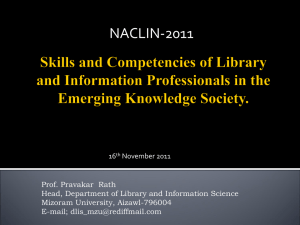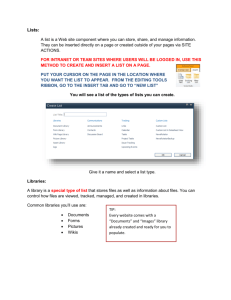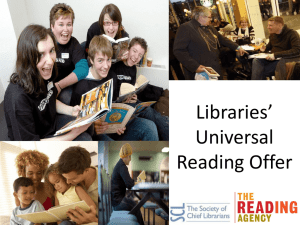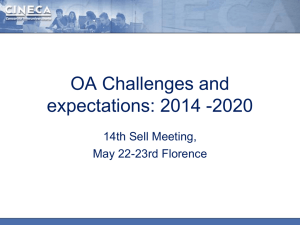Aligning National Approaches to Digital Preservation II (ANADP
advertisement
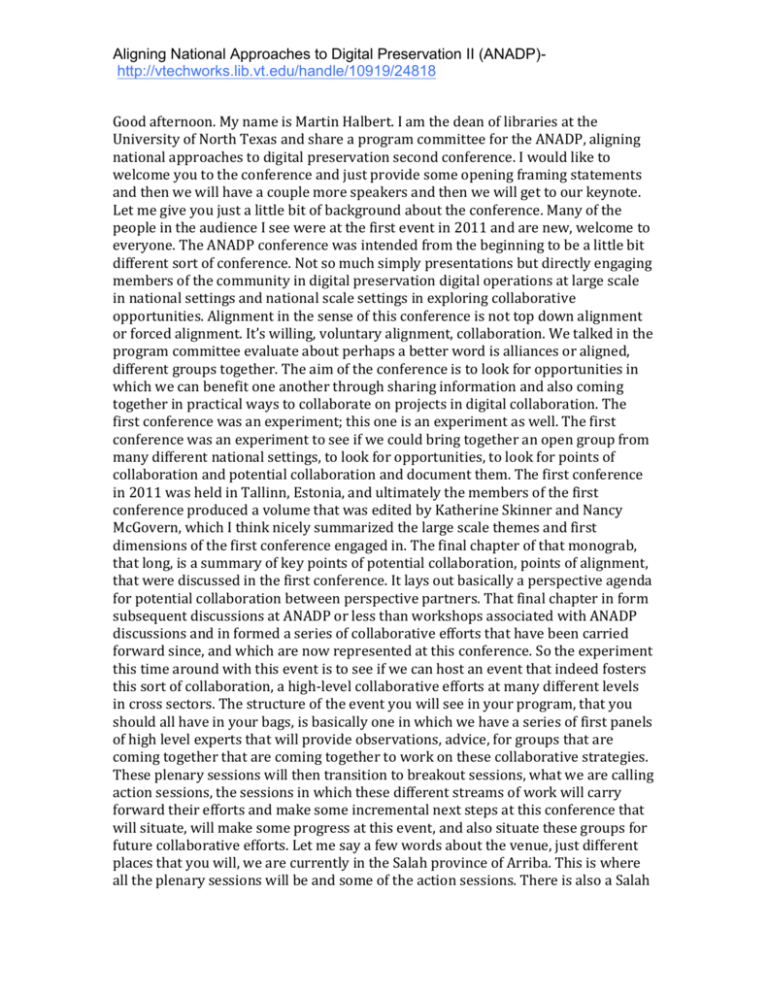
Aligning National Approaches to Digital Preservation II (ANADP)http://vtechworks.lib.vt.edu/handle/10919/24818 Good afternoon. My name is Martin Halbert. I am the dean of libraries at the University of North Texas and share a program committee for the ANADP, aligning national approaches to digital preservation second conference. I would like to welcome you to the conference and just provide some opening framing statements and then we will have a couple more speakers and then we will get to our keynote. Let me give you just a little bit of background about the conference. Many of the people in the audience I see were at the first event in 2011 and are new, welcome to everyone. The ANADP conference was intended from the beginning to be a little bit different sort of conference. Not so much simply presentations but directly engaging members of the community in digital preservation digital operations at large scale in national settings and national scale settings in exploring collaborative opportunities. Alignment in the sense of this conference is not top down alignment or forced alignment. It’s willing, voluntary alignment, collaboration. We talked in the program committee evaluate about perhaps a better word is alliances or aligned, different groups together. The aim of the conference is to look for opportunities in which we can benefit one another through sharing information and also coming together in practical ways to collaborate on projects in digital collaboration. The first conference was an experiment; this one is an experiment as well. The first conference was an experiment to see if we could bring together an open group from many different national settings, to look for opportunities, to look for points of collaboration and potential collaboration and document them. The first conference in 2011 was held in Tallinn, Estonia, and ultimately the members of the first conference produced a volume that was edited by Katherine Skinner and Nancy McGovern, which I think nicely summarized the large scale themes and first dimensions of the first conference engaged in. The final chapter of that monograb, that long, is a summary of key points of potential collaboration, points of alignment, that were discussed in the first conference. It lays out basically a perspective agenda for potential collaboration between perspective partners. That final chapter in form subsequent discussions at ANADP or less than workshops associated with ANADP discussions and in formed a series of collaborative efforts that have been carried forward since, and which are now represented at this conference. So the experiment this time around with this event is to see if we can host an event that indeed fosters this sort of collaboration, a high-level collaborative efforts at many different levels in cross sectors. The structure of the event you will see in your program, that you should all have in your bags, is basically one in which we have a series of first panels of high level experts that will provide observations, advice, for groups that are coming together that are coming together to work on these collaborative strategies. These plenary sessions will then transition to breakout sessions, what we are calling action sessions, the sessions in which these different streams of work will carry forward their efforts and make some incremental next steps at this conference that will situate, will make some progress at this event, and also situate these groups for future collaborative efforts. Let me say a few words about the venue, just different places that you will, we are currently in the Salah province of Arriba. This is where all the plenary sessions will be and some of the action sessions. There is also a Salah Aligning National Approaches to Digital Preservation II (ANADP)http://vtechworks.lib.vt.edu/handle/10919/24818 Cartatha, and instead of what are marked in the program as patio sessions, well, you’ve seen the weather, so we’re probably not going to be doing any patio sessions, it’s a little wet outside. But instead, we have decided to do the patio sessions indoors in a room called the Salah Bendreya. In each case when we make the breaks, the transitions from plenary sessions to breakouts to the action sessions, there will be volunteers out here that will lead you to the relevant rooms, the other two rooms, the Cartatha and Bendreya. Ramon, can you hold up your hand? Ramon and his team of volunteers that you will find out there that are manning the registration desk, will be available to lead everyone to the breakout sessions that are not here in the Ratala Riva. There are also bathrooms right across the way and it is a lovely venue and I really appreciate the hospitality of our local hosts. You will hear in just a few minutes from Lluis Anglada, one of our hosts, about the Bibliotheka Canlona and the Institute for Kellam and Studies where we are now. A couple of more things in the program, there is a change to the dinnertime, in the program it is listed for tomorrow night at 7:00, will actually be at 8pm, so just a little later. There are maps available, I think in the bags, that mark out the locations of both the reception tonight and the dinner tonight. The reception tonight will be a wine and beer and appetizers session that is in a lovely location, a Palau, which for those of us who do not speak Catalonese, means palace, there are many of them here in Barcelona. The Palau Moya, which is a lovely venue and I hope that you join us. It will be fairly early, so you can socialize a bit, and then go to dinner with your colleagues, and then we will have the big group conference dinner tomorrow night. At the reception tonight, we will have a lovely performance of Catalonian guitar music, I am told it is quite intense, something to be experienced, and I am looking forward to it, but we will have plenty of opportunities both tonight and tomorrow and in the breaks for socialization and networking, which is a key part of this conference. It is really to enable people to come together that maybe have worked in the past or maybe have never met one another before, and to have the opportunity to discuss things and possibilities of collaboration. I would encourage anyone who has not seen the monograph, the line from the first event, to take a look at it. It is freely available up online and the final chapter again of these identifies the 47 points of perspective alignment, the 7 action sessions that are at this event are obviously not covering all of the perspective points of collaboration that were defined in the volume, but we think that it will make a good start and we think just to be practical, we should start somewhere, and starting somewhere is better than not starting. So this is at least an opportunity to begin to explore some of the potential ways across these different tracks, in terms of technical specifications, organizational information, sharing many of the types of collaboration that you will find in the action tracks. Because we will have to take people to the rooms, they are located in different parts of the complex, we encourage you to think ahead about the action sessions that you want to attend, so you know which group to go with, and the volunteers will lead you to the different venues. As we get started, I would like to thank the program committee. Could members of the program committee that have been working on this for so long stand up or raise your hand for just a moment? Thank you folks. I would very Aligning National Approaches to Digital Preservation II (ANADP)http://vtechworks.lib.vt.edu/handle/10919/24818 much like to thank the sponsors who are too numerous to go through individually, but you will find all of them listed on the inside cover of the program, and this event would have not been possible without them. Events of this type take a lot of resources to put together and we very much appreciate all of the sponsors and their contributions to this event. I think they are leading these digital preservation efforts in many different ways, we had a large cross section of different types of sponsors, nonprofit organizations, universities, corporations, all sorts of different groups, and we very much appreciate all of their contributions. You will hear more about the aims and the discussion in each of the plenary panels as they come up. In just a moment again, we are going to go to our keynote, but first I would like to invite Lluis Anglada, my kind colleague here, at Barcelona, to come up and say a few words. Thank you, Martin. Well this wasn’t planned, because I am substituting for Ramal Excalade, our minister of Catalunya of this Catalonia. Mr. Excalade had a problem and he’s changing his agenda. Sorry for that. Sorry because it’s me who will be representing that the local or community organizer committee. We try to align the weather with the program, but it’s been impossible. We also try to align the program with the facilities and I think that you will enjoy, because this room is not only nice but is also comfortable for these kind of events to discuss with the … meets. My English isn’t as well as Martin suggested, said. Me and the director of the construction of academic libraries of Catalonia and we are the organizers together with the national libraries of Catalonia. We’ll talk a bit tomorrow. And also we had the help of the faculty of the Barcelona University and the volunteers are students that studies in the library. So I, let me say that I studied here, very close to here. This is a historical building. Well the national library, this is a fantastic library that’s also a fantastic building. Or fantastic building that’s also a fantastic library that I certainly recommend to visit. The building is impressive. It was a hospital until the end of the 19th century, the beginning of the 20th century. Even Antoni Gaudi, the architect of the Sagrada Familia, at the end of his life died or was here (Biblioteca de Catalunya) not as a reader but because it was here. But I say that because all these buildings, all of these ones buildings built at the end of the 19th century, not Biblioteca de Catalunya but the other ones still, la Plaza de la Universidad, those are very beautiful buildings, the charity buildings, the ones to orphans, and so it’s a charity. You are inside the whole of Barcelona, the opening and creating these that we call the chapler in the mid-90s but until now. And this was the creation of a new city, but before that they had to build public buildings like this one in the 90s. So this building hosted this moment in the national library and also this institution called the studies catalan, that is like academia scholastic society. But it hosted also the school of labor and faculty some years ago, so we studied here. Let me say that Catalonia, well we in Spain, welcome to Barcelona. Catalonia is a formal region of Spain with its own history and language. And from the point of view of the language and particularly the history, because the first school of librarianship European in the country, but not the UK, was in Barcelona. Because at the time we lead the good moments, you know with the industrial revolution in Spain took place in first time in the Basque country and also in Catalonia. And the Catalan people at the time Aligning National Approaches to Digital Preservation II (ANADP)http://vtechworks.lib.vt.edu/handle/10919/24818 wanted to improve the society through improving the status. So it seems quite contemporary. Now we are trying to do the same. So they created more or less 100 years ago institutions in order to help people gain access to the knowledge. This meant schools, technical schools, but also libraries. The public libraries and the national libraries, sorry Eugenia if I’m talking about what is your specialty and what you are representing. I say that because we have more or less 100 years in this century, which has been quite complicated in Spain but where the library in shaping Catalonia has been quite very well with the method. And I think that we are quite proud of some of the realities. The national library is a fantastic library that you came to visit. Not only owns all books, but also is very active in the new technologies. Sorry again Eugenia, but not only presenting digital, but also this is engaging across project now and leading some cooperative efforts in order to preserve the memory. We have seven public universities and five primers more or less well organizing. I think that we are quite modern. We work together through the construction. I think that we put to modernize our services. Our public libraries we have, let me see, 365. So public libraries, one for every day, if you visit us and get to spend one. Sometimes public libraries are pretty but they close on Sunday. So you need more than one year to visit all if you schedule one day for each one. Some of these public libraries are quite new and also beautiful, well organized. Sorry to be proud of that within the last 20 years. Our weakness, talking about libraries, are the school libraries and also the research libraries. School libraries we never had enough power to be able to be there, to change the *cough*. Also I think that we need to think together. I ask to my Catalan colleagues here to present also if you agree with me that to engage and to be aligning that we need to improve the support that we are giving to the research. Research is very important in the world. Research is important in Catalonia. Our schools improve a lot in the last 15 years. We have good results if we compare the application and the production. Our results are not so good if we compare the patterns and the application. But also in my opinion information will be very, very important in the research process and what it is to show to the researches that we, as librarians, we can add value to offer service. This includes the preservation of information of electronic data. This from a third perspective, I am a member of the legal board. Legal board has a new statistics program. The new statistics program is very clear. We want to appreciate the whole library and we want to be engaged while the new research libraries need to be more useful to the research that has been in the past. Or in a different way that has been in the past. And to be more useful for the research this means forming new laws and to be able to, not to forget because we still need that, but we save resources in the additional areas that libraries invest their resources, like at the logging to organizing the Brit collection and to open new doors. To help people to put the albums of their research in access to assist researchers in the hope that to make it righter, but also to help researchers to collect the data, to organize the data, to put the metadata, and to collect to preserve inventory information. Thank you to be here. I know that to travel is difficult. We all have a lot of delay today. It seems that Barcelona asked us to take one weekend to travel so thank you to be here. I am Aligning National Approaches to Digital Preservation II (ANADP)http://vtechworks.lib.vt.edu/handle/10919/24818 sure that the conference will be great and we, in representation of Eugenia and Ernesto and the faculty, we welcome to Barcelona and we want for you a great success for this conference. Thank you. Aligning National Approaches to Digital Preservation II (ANADP)http://vtechworks.lib.vt.edu/handle/10919/24818



